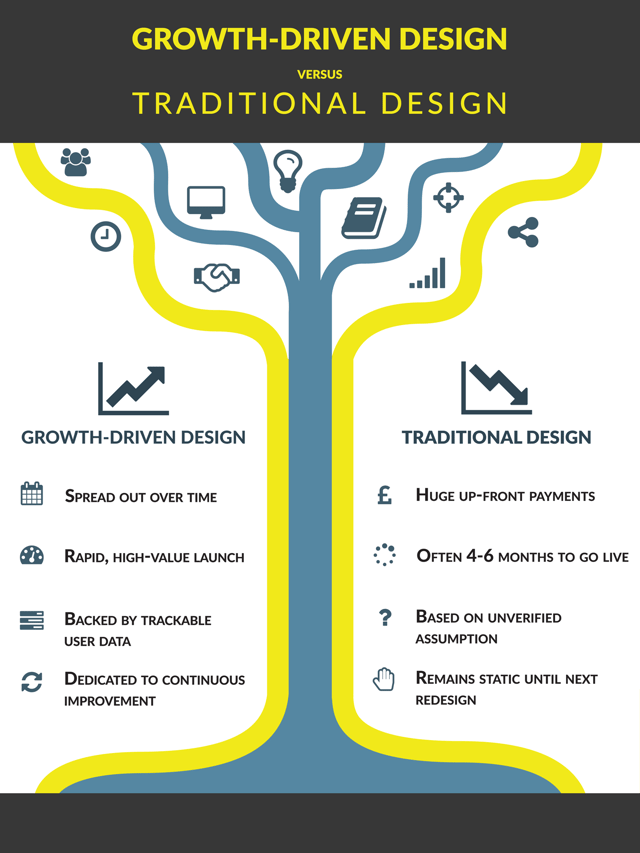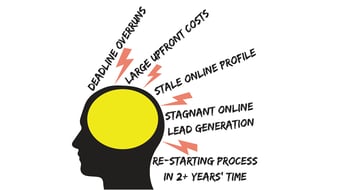Growth-Driven Design (GDD) is reshaping the way we think about web design and the way users engage with a business. It’s a conscious reshuffling of the values adopted by traditional website design.
The need for the comparison and contrast is due to the unwieldy and problematic nature of traditional web design, which has become a hindrance for businesses. Between missed deadlines, over-delivery and the long, drawn-out processes by which traditional web design is defined, many professional services companies are looking elsewhere for their business.
Here, we will weigh up both processes and shine a light on their benefits to your company (as well as revealing their shortcomings). We understand that with GDD being relatively new, some professional services companies may be a bit hesitant.
Take comfort: GDD has a detailed, structured process and is backed by real-life data.
Without further ado, it’s time to compare; growth-driven vs traditional web design. What's better? Who will reign supreme? Read on to find out...
Cost
Whether your business is an industry-leading high flier or just a startup finding its wings, cost is always a huge factor.
So, the first thing you should know about growth-driven design is that the cost is spread over a period of time.
This is where traditional web design falls short. On many web design campaigns, businesses are faced with a one-time, up-front cost that accounts for the whole project.
By contrast, through a growth-driven design route, you have the advantage of working with an agency dedicated to making sure the website keeps improving. Agencies using a GDD methodology have a great incentive to ensure the site gets better each month with each iteration.
It’s not built and discarded, but a living, breathing, tangible product designed to evolve for the clients and their customers.
Launch Time
A point of pride for GDD is that a launch pad website can go live after just 30 days. Containing only the highest-value core elements, the launch pad site is fleshed out through gradual upgrades, over a period of time.
The reality of traditional website design, on the other hand, is that projects often go over-scope. Deadlines can sail by in the blink of an eye, leaving frustrated clients without a website and the prospect of further costs.
The launch time for traditional design is lengthy, too; possibly as long as six months, with lead generation turning stagnant in the meantime.
That GDD offers such quick go-live times makes it all the more attractive for business goals. The quicker a website goes to market, the sooner your business can learn from its users and reap the rewards.
User Experience (UX)
Now for a real game changer: GDD’s use of visitor insights.
GDD marks a real turning point in web design because it listens attentively to users. By tuning into engagement reports, click-through-rates and heat mapping to track user experience, GDD teams are enabled to actively respond and take steps to improve the Launch Pad website in highly valuable ways.
In basic terms, growth-driven web design gives UX full, undivided attention. And given the growth of UX influence in SEO, users and brands alike can benefit from growth-driven design methodology.
However, the values of traditional web design, have become rooted in the interests of designers themselves. Web design teams can often become insulated within and around their projects, and as a result make it harder for them to think like a user.
Where GDD sources real-life data, traditional design has often been guilty of making assumptions about data with an almost ‘finger-in-the-air’ approach. Once again, the advantage of selecting a GDD agency reigns supreme.
Continuous Improvement Phase
Thanks to the Launch Pad website, data is now available to drive ROI and formulate new ways to improve website UX for visitors. GDD continues to hone in on the Launch Pad website even after it has gone live. This transforms a brand’s website from the initial, high-value, minimalist framework into a multi-structured, hyper-optimised lead generation machine.
On the other side, for all the work that goes into a traditional design plan, once the project is signed off it is often forgotten about (until two years of general inactivity has passed, of course).
Just think: that time could instead be spent using reliable information to tweak and improve the overall online product over time.
Suffice it to say that GDD is a more whole-hearted, data-oriented approach that bolsters user experience, drives leads and attracts visitors.
Conclusion
In terms of cost, time, data and actual improvements made to the site, GDD outpaces traditional web design by a wide margin.
The key takeaway is that GDD listens to the user; it gathers data to mount a push for the client and strives to enhance the website’s lead generation capabilities over time.
Traditional? It’s far less interested in the user, so much so that many businesses are noticing the benefits of GDD and what it can do for their revenue. We invite you to join them in this discovery.
Please visit our Growth-Driven Design page to learn more about our approach to this agile and user-friendly technique.





